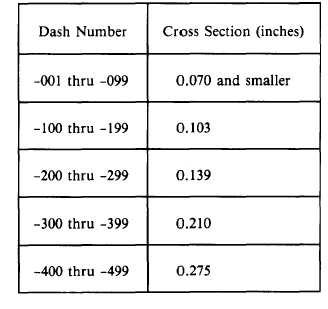Sizes
A standardized dash number system for
O-ring sizes is used in many military and industrial
specifications. The O-ring size is identified by a
dash number rather than the actual dimensions
for convenience. The basis for the dash numbers
is contained in Aerospace Standard AS568. For
nongasket O-rings (packing), the dash numbers
are divided into groups of one hundred. Each
hundred group identifies the cross section size of
the O-rings within the group (table 7-2).
The 900 series dash numbers contained in
AS568 identify all the presently standardized
straight thread tube fitting boss gaskets. With the
exception of -901, the last two digits of the dash
designate the tube size in 16ths of an inch. For
example, the -904 size is for a 1/4-inch tube.
Dimensions
The critical dimensions of an O-ring are its ID,
its cross sectional diameter (W), and the height
and width of the residual molding flash (see
fig. 7-7).
Nominal dimensions have been used to
describe O-ring sizes, although this practice is
rapidly being replaced by the use of dash numbers.
The actual inside diameter of a seal will be slightly
less than the nominal ID, but the actual OD will
Table 7-2.—O-Ring Dash Numbers Versus Cross Section
Sizes
be slightly larger than the nominal OD. For
example, an AS568-429 O-ring is described in
nominal dimensions as 5 inches ID by 5-1/2 inches
OD by 1/4-inch W. Actual dimensions are 4.975
inches ID by 5.525 inches OD by 0.275 inches W.
Specifications
Material and performance requirements
for O-rings are often identified in military
specifications. The dimensions of these O-rings
will usually be found in accompanying slash sheets
(which bear the specification number and are a
part of the specification) or will be identified by
various drawings and standards that relate to the
specification. Included among the specifications
are Air Force-Navy Standards (AN), Mili-
tary Standards (MS), and National Aerospace
Standards (NAS). If the specification does not
identify sizes, the sizes should be identified by the
AS568 dash number. Usually, you can use
drawings, technical manuals, and allowance parts
lists (APLs) to identify replacement O-rings.
(Notes 2 and 3 of table 7-1 list some of the
frequently used military specifications).
Cure Date
A cure date is as applicable to natural or
synthetic O-rings as it is to rubber hoses. This date
is the basis for determining the age of O-rings.
It is extremely important that the cure date be
noted on all packages.
Shelf Life and Expiration Date
All elastomers change gradually with age;
some change more rapidly than others. The
shelf life for rubber products is contained in
MIL-HDBK-695.
Check the age of natural or synthetic rubber
preformed packings before installation to
determine whether they are acceptable for use.
Make a positive identification, indicating the
source, cure date, and expiration date. Ensure that
this information is available for all packing used.
Shelf life requirements do not apply once the
packing is installed in a component.
The expiration date is the date after which
packing should not be installed. The expiration
date of all packings can be determined by adding
the shelf life to the cure date.
7-8

